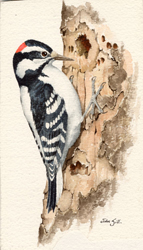Breeding Bird Atlases (BBA)
Find a Bird - BBA1
Breeding Bird Atlas 1 Species Accounts
Hairy Woodpecker
Picoides villosus
Egg Dates
April 22 to June 5
Number of Broods
one; may re-lay if first attempt fails.

Together with its close relative, the Downy Woodpecker, this species has an extensive range, occupying virtually all of forested North America south through the highlands of Central America to western Panama. It is everywhere less common than the Downy Woodpecker, but like the latter inhabits mainly deciduous forests and, in the Northeast, seems attracted to wet woodlands. The Hairy Woodpecker will also nest in more open situations such as orchards and shade trees. The species is found throughout the state, even breeding on parts of the Cape and Martha’s Vineyard, but not on Nantucket.
During the winter, the female hairy remains on or near the breeding territory while the male, distinguished by his red nape, may be more wide ranging. Pair formation often begins in late winter but becomes accelerated and most obvious in April, at which time vocalizations accompany much of the daily activity. The common call note, keek, is louder and sharper than the similar note of the Downy Woodpecker. Another call is a loud, prolonged rattle resembling that of the Belted Kingfisher, but it is of shorter duration and is usually preceded by a single introductory note.
As the time of breeding approaches, drumming becomes a familiar ritual. This is usually performed on a resonant dead branch or tree trunk, and the rolls are shorter and louder than those of the downy. A courting male may pursue a female from tree to tree. Both members of a pair dodge about the trunk and branches and engage in posturing together, frequently spreading the wings while holding the bill on an axis parallel with the body. These activities are accompanied by muted, flickerlike wicka calls.
Either live or dead trees are chosen for the nest hole, with excavation by both sexes taking up to three weeks if a live tree is selected. Twelve nests in southeastern Massachusetts were located as follows: 6 in dry upland woods, 2 in maple swamps, 3 in apple orchards, and 1 in a tree in a swampy meadow. Nest trees were maple (3), apple (3), chestnut (2), poplar (2), dead oak (1), and dead beech (1). The heights ranged from 5 to 30 feet above the ground (ACB). Forbush mentions a nest 12 feet up in a live oak. In southern Worcester County, 2 nests were found in live Red Maples in swamps, 1 in a poplar in young second-growth forest, and 1 in a dead branch of a Red Oak (Meservey). Typical nesting cavities are 10 to 15 inches deep and have a circular or slightly elongated entrance hole about 1.5 inches in diameter.
The three to six (average four) white eggs are laid on a bed of wood chips at the bottom of the cavity. The clutch sizes for 6 Massachusetts nests were as follows: two eggs (1 nest), four eggs (5 nests) (DKW). Incubation, by both sexes during the day and the male at night, lasts about 12 days. During the early nestling stage, the young are fed by regurgitation, but later whole grubs or beetles may be brought by the adults. In Massachusetts, nestlings are generally reported in May and June. Before they fledge, the nestlings begin to climb to the entrance hole, where they greet their parents with a noisy, purring, food-begging call. The young leave the nest 27 to 30 days after hatching. At one Massachusetts nest, at least one youngster fledged on June 3 (CNR). Fledglings resemble adults, but males have red, pinkish, or rarely yellowish crowns. These disappear with a molt in late summer, at which time the adults also renew their plumage. There is only one brood a year, but a pair may renest after an unsuccessful attempt.
Juveniles receive some food from the adults until they are 44 days old. The late date for an immature accompanying an adult to a suet feeder is July 21 (Ober), but the birds may roam through the woods in a loose family group until late August. Insects make up the bulk of the diet, with some seeds and fruits also taken. Individuals of both sexes excavate one or more roosting holes.
The Hairy Woodpecker is a year-round resident, but there is a dispersal of some young birds each fall, and in occasional years adults as well as young emigrate out of Massachusetts. During the fall and winter, these woodpeckers are encountered frequently in towns and backyards. American Elms inflicted with Dutch Elm Disease are favored feeding sites during the winter months.
Map Legend and Data Summary
Atlas 1 data collected from 1975-1979


Note: uncommon in mature deciduous wet woodlands; much scarcer on the Cape and Martha‘s Vineyard
Richard A. Forster



